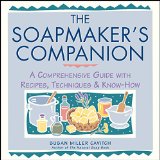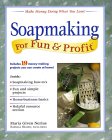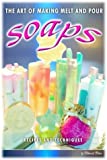Soap is a basic necessity for a good life. When the lights go out on Western Civilization, where will you get soap? You will make soap yourself, that is what you will do!
There is no need to wait for a survival emergency to learn and practice the art of soap making.
Making soap is practical, economical, and fun.
Traditional Soap Making
Making soap from ashes instead of caustic soda.
Soap Making Recipes from Elaine White
Soap Making Recipes from the author of Soap Recipes
Directions for making soap
Simple soap making directions for a variety of soap recipes.
How to make soap in a blender
Directions for making soap using a kitchen blender.
Soap Making: The Way We Used To Do It
Instructions for soap making from the early 1900’s.
Soap making - General Instructions
Soap making is not hard to do if you are armed with just a little bit of information. Soap is the result of combining fats with some sort of caustic agent such as lye using water as a catalyst. Armed with just a little bit of knowledge it is possible to turn out a nice batch of soap with things that can be purchased at most grocery stores. Read on to get the specifics on this fun and interesting hobby. Study this page carefully and you shouldn’t have any problems turning out a great batch of soap.
A Soap Making Recipe for Beginners
Cold Process Soap for One 12 oz Can of Lye.
Soap Making: Rebatching
Rebatching: Making new soap out of old.
Soap Cooking In A Modern Setting
Most soap making recipes found today aren’t cooked. However, cooking does offer some advantages when making soap.
Basic Hand Soap
Instructions for making hand soap.
Basic Perfumed Hand Soap
Instructions for making perfurmed hand soap.
Soap from homemade fat drippings
Instructions for making soap from fat drippings.
Basic Granulated Laundry Soap
Instructions for making granulated laundry soap.
Laundry Soap
Instructions for making laundry soap.
Basic Shampoo
Instructions for making shampoo.
Finding Soap Making Supplies
This page will help you find your soap making supplies locally and at the best prices you can find.
Determining You Soap’s pH
Instructions for determing the acidity of homemade soap.
The Way Al Makes Soap
In 45 minutes I threw the following batch of soap together so I could get some pictures. The process doesn’t take long. As the years have passed, my methodology has changed from the early days when I was doing so much experimenting while I learned the art. What follows is how I now make virtually all my soap.
Soap Making Recipes
A searchable database of soap making recipes.
Professional Lavender Soap Recipe
Recipe for making long-lasting quality bar soap.
What is Cold-Processed Soap?
Lisa Lisa’s Famous 12-step Soap Recovery Program
Rebatching (or handmilling) soap is one of the harder tricks to master. Rebatching, as soapers call it, is simply making a soap, then melting it down again. During the rebatching process, you can add essential oils or herbs (or even things like fruit) that would otherwise be destroyed by the exposure to alkalis.
Zenda’s Homemade Soap and Beauty Recipes
Simple soap making recipe
Colonial Soap Making: Its History and Techniques
This booklet will provide persons interested in the ways of early American life some information about soap and soap making. Soap making is a homestead skill often forgotten in discussions of colonial days. Soap was of great value in keeping the household a far better place to live and work.
A Lesson in Soap Making
Most recipes for soap making are for large batches of 64 or 100 bars or more. Since you probably don’t buy lard by the 55 gallon drum, nor own a caldron that seats six this may be a little impractical. This recipe is for making about two bars of soap, just enough to experiment with.
How To Make Soap
How to make soap in a chemistry lab.
How To Make Soap From Scratch
Making soap base is a cumbersome task. However, it is also rewarding to change the nature of natural things. What once was fat, water, and lye turns into a beautiful, rich, and creamy soap.
Soap Making Safety
Soap Making Safety
Lye, it is an ingredient in every soap. Unfortunately, it is also a very nasty chemical, and extreme caution needs to be used when handling, storing, and using it. Lye can cause serious damage to people and many inanimate objects as well. If you are careful and follow the rules, then it can be handled in relative safety.
What’s a Little White ‘Lye’ Gonna’ Hurt?
A lot! Lye can hurt, harm, maim, and kill. You say, “But I want to make soap!” Great! It’s totally possible. And it’s a necessary ingredient. No lye, no soap. Your grandmother made soap and she survived, right? Well, you can too, of course! And homemade soap far excels what you buy in the store. However, working with lye takes self-education and certain precautions. Lye is a toxic chemical. It can cause burns, anywhere from being merely irritating, to severe, requiring hospitalization. Spills can destroy furniture or appliances. Fumes can damage lungs, permanently. The worse case scenario is: if it is accidentally ingested, lye can be fatal.
Rendering Fat for Soap Making
Rendering Fat
Instructions for rendering fat in preparation for soap making.
How to render tallow for soap making
Instructions for rendering tallow from beef fat.
Calculators and Tables for Soap Making
Lye Calculator
Majestic Mountain Sage’s Lye Calculator is a tool for soapmakers to create new soap recipes. The Lye Calculator will calculate the amount of lye (either sodium hydroxide or potassium hydroxide) required to convert the specified amount of fats and oils to soap.
Fragrance Calculator
Calculator for determining how much fragrance to add while making soap.
Lye Calculator
Lye Calculator for Microsoft Excel
Lye to Fat Ratio Table
This table is for those of you who want to get a bit more scientific in soap making, or just want to check and see if the person who created the recipe you’re planning on using knew what they were doing. Each fat has its own saponification value, or “SAP Value.” And because of this, each fat requires a different amount of lye to convert the fat to soap.
Saponification
A Lye Calculator for Microsoft Windows.
The Amount of Lye Required to Make Soap
In this chart, the math has been done for you. All you have to do is multiply the number of ounces (or grams) fat you would like to use, times the number in the chart. The answer is the number of ounces (or grams) lye (sodium hydroxide) required to saponify that much fat.
The Chemistry of Soap Making
Making Soap with James Hershberger, A Chemical Engineer
What is soap and how does it work? Soap is saponified fat; a chemical reaction that takes place between oil and lye. I’m often ask the question, “Can I make soap without lye or some other caustic agent?” The answer is, “No.” Some places sell spaghetti for “making soap” but this is already soap. This is only a remelt or a “rebatch operation.”
What is soap made of?
Soaps are made of molecules that are both fat and water soluble. The molecule has a long hydrocarbon tail that allows it to dissolve grease, and a polar head that is water soluble.
Detergent Chemistry: Synthetics Introduction
If you look up detergent in a dictionary it is simply defined as cleaning agent. During the last two to three decades, however, the word detergent has tended to imply synthetic detergent, or syndet for short, rather than the older soap. In fact, commercial formulations consist of a number of components, and we shall use the term surface-active agent, or it’s abbreviation surfactant, to describe the special active ingredients that give detergents their unusual properties.
Introduction to Surficants
Molecules or ions which are amphiphilic, that is they contain both a hydrophobic and hydrophilic part, in aqueous solution frequently assemble at interfaces. This property has given them the name surface-active agents which is very often abbreviated to surfactants. The hydrophobic, usually hydrocarbon portion, which can be linear or branched, interacts very weakly with the water molecules in an aqueous environment. This is due to the strong interactions between the water molecules, arising from dispersion forces and hydrogen bonding acting cooperatively to squeeze the hydrocarbon tail out of the water. Hence the tail is usually termed hydrophobic.
Bath (Soap) from Caveman Chemistry
Humorous historical and scientific story of soap.




